Dark spots on tomato stems. Gray rot on tomatoes, signs and ways of struggle
Gray Gnil In certain regions, it makes a very serious damage to growing tomato. First of all, these ailments are affected by plants whose stalks were damaged during the care of them. The development of sulfur rotty usually falls on the stage of fruiting tomatoes, and the best of all this attack is developing when the wet weather is established. If you do not provide to the growing tomato to the proper care and not to begin timely fighting with a gray rot, it will very actively spread to the greenhouse, hitting the tops of the shoots, as well as inflorescences with conventional fruits.
A few words about the disease
On the brought by destructive gray rot, the tomato nodules begins the formation of grayish-brownish specks, gradually covered with an unpleasant gray raid. And in the nearest sites near the departures of the leaf, the malicious attack is manifested in the form of brownish elongated specks. For three or five days, all the specks grow on stems up to four or five centimeters, covering them around the perimeter. A little later, they pale in the middle to the pale straw shade, and on them with attentive consideration you can see ring-shaped blurred stripes. By the way, in the first six to eight days after the appearance of such spots, there are no signs of mushroom spout.
Inside tomato stems, necrosis of the bark and vessels is often developing, as a result of which there is a cessation of water intake, which in turn provokes a ray of plants. Located slightly above the necrosis of the leaves are yellow, and the formation of an impressive number of air roots begins on tomato skelters.
With the damage to the gray rot, the spots located above the plants are often faded. And about a week-to-one and a half along the edges of the specks (and sometimes in the center), the ash-gray flare is formed. This is a conidial fungal spioning.
In case of rainy weather, as well as high humidity The air is ill-faced attack can affect and flowers with fruits. By the way, for the specks formed on them is characteristic of the rounded form.
How to fight
Despite the fact that protective measures against the gray rottomas are well developed well, they are often used with some delay, and this in turn partially reduces the effectiveness of the events.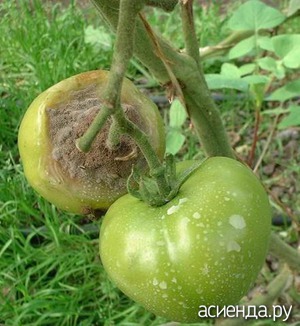
The most important protective measure against the ill-fated disease is considered to be maintained in greenhouses of rather low air humidity. To reduce the wound surfaces of the plants and thereby preventing the beneficial penetration of infection, with tomatoes it is important to contact the most accurately not only when the leaflets and fruits are removed, but also in the formation of crops. For this purpose, damaged parts of the stalks and the leaves are important to trim only in dry weather and an exceptionally sharp knife.
It is extremely important to remove the remains of plants from the greenhouses, since they contribute to further infection of tomatoes. And the specks on the affected cultures are often deceived by special paste with fungicides.
Reduce the development and further spread of the stem shape of the destructive gray rottoma rot, the treatment of the growing cultures of sodium humate cultures help.
In the prophylactic purposes, the tomato stem is treated with a suspension of Triphodermina. It is especially useful to carry out such machining after the removal of leaves (in order to keep the development of secondary foci of infection). And among chemical preparations In the fight against the gray rot Tomato, the drugs "Bayleton" and "Eupaaren Multi" have proven.
Gray rot is widespread in protected ground, but especially malicious in film greenhouses. All the above-ground organs of plants are affected - leaves, stems, inflorescences, fruits. Brown mocking spots appear on the fabric, which are soon covered with a rich gray raid. On the stems, mainly at the bottom, are visible elongated spots of gray or brown color. At first they are dry, then they are slightly doned. Over time, sharply stem. During the growing season, the disease spreads during watering and caring for plants. The disease is stronger than plants damage (stepsing, garter, etc.), but the infection can penetrate the tissue and without damage.
Development of the disease contribute high humidity (90-95%) and air temperature 17-25 ° C, weak light and thickening landing. The source of infection is the soil and affected plant residues on which the arms disputes are saved.
Consistently resistant to the disease are tomato varieties. Offot and Leningradsky.
Prevention and treatment of tomatoes from gray rot
1. Conduct the disinfection of the greenhouse by burning sulfur briquettes.
2. Reduce the relative humidity of air by ventilating.
3. When the symptoms of the disease should be processed by the affected places of stems with crowded charcoal, chalk, ash, mangartan or copper vitriol (5 g per 1 liter of water).
4. Do not thwart the landing.
Vintage from his garden requires a lot of effort and hassle from the owner. This is constant care, and material costs for the purchase of specialized goods, such as fertilizers and pesticides. And in the case of planting plants in the construction of the greenhouse, the costs of maintenance in the proper order of the latter appear also. Landscaped greenhouse is shown in the photo.
Tomatoes in Teplice
Greenhouse is a good help for the gardener. It can create all the conditions for growing many cultures. In general, this is a great way to get a harvest, not even in a very warm period of time. But if there is no observance of any rules of operation of such a device as a greenhouse, a temperature difference may occur, which will undoubtedly affect plants there are, and the consequences will be negative.
It comes the time when seedling is planted, fertilizers are applied by appointment, and on the shoulders of the garden, only timely weeding and watering remains. It's time for the harvest becomes gratitude for the worker, his works are returned to the table in the form fresh vegetables and fruit.
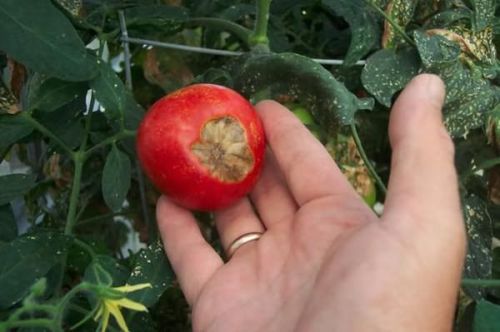
But what to do if the unexpected problem of rotting appears if the expectations of collecting deserved fruits appear? How to fix the situation and get at least some harvest? Answers to these questions can be found in various sources. Impact measures differ depending on the type of affected plant and the infection, which was picked up.
Consider such vegetable culture like tomato. Without it, probably no mistress does not do when cooking, so it is present almost on any garden. The greenhouse also does not do without this culture. Tomato varieties and varieties are a great set, but, unfortunately, there are many diseases in this culture. Even the rot can be different, as a result of which methods of combating it will also be varied.
It all depends on the source of infection. Everything, as in other organisms inhabiting the planet. The same bacteria, fungi, viruses and other microorganisms. You can also select infectious and non-infectious causes of appearance. In the first case, the pathogen appears from external environment, penetrate the fruit and begin their unfavorable activities, in the second disorders begin due to genetic causes, improper care or its absence, as well as any unintentional causes, for example, inappropriate climate, elevated or reduced humidity.
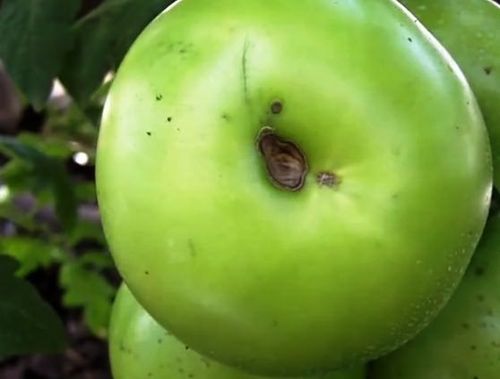
Vertex
The most common disease that affects mostly ripe fruits. The vertex rotten of tomatoes in the greenhouse reduces the number of collected fruits. It is manifested in the form of a dark rotting spot, which slowly grow up, gradually capturing the entire surface. It may develop due to bacteria and improper care. The lack of moisture plays a big role in this case. And the absence of loosening leads the deterioration of air permeability. Most often, fruits having an extended form are exposed to this disease. In the infectious method of infection, the fruits will deteriorate massively.
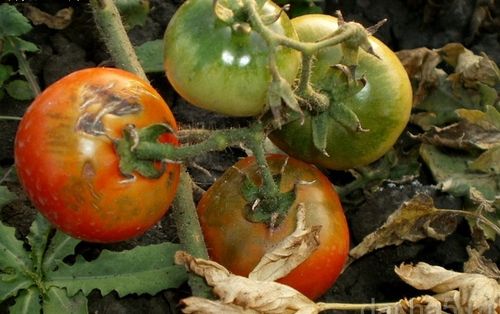
How to deal with the vertex rotten of tomatoes in the greenhouse? When the first signs need to take action immediately. Treatment is made by improving the culture care, for example, cutting with a stepmother, if this action was not carried out earlier, tapping bushes, irrigation regulation, and the creation of too long gaps between irrigation is destructive for harvest. The most effective measures can be attributed to:
- Spraying plants and infusion under the root of a solution of calcium nitrates. It is not necessary to pronounce. The operation must be carried out 1-2 times a week. The solution is made in the calculation of 10 g of a chemical on the water bucket.
- Irrigation with a chalk solution. People's way. The effect requires a longer use period.
In fact, the struggle against the vertex rotten of tomatoes in the greenhouse is constantly being conducted. What a vertex rot on tomatoes in the greenhouse can be seen in the photo.

Gray Gnil
Signs of this disease are similar to the previous one. The objects of the lesion are not only the fruits, leaves and stems can also suffer. Methods of struggle are simple. It is necessary to remove all the mushroom infections of the plant. Brown spots with watery content appear by the end of the growing season. The disinfection of the soil can bring very good benefits on which the beds of tomatoes are located. The gray brick of tomatoes in the greenhouse is very common, as well as white. On photo White rot.
Root rot
By name it is clear that the root of tomato is affected. In this case, unfortunately, only the disinfection of the soil can help. With more severe case root rot will need to replace upper layer Soil. Of chemicals Solution will help copper Kaper. It is necessary to use it when infused under the root of the affected plant. Root rot Depicted in the photo.

Inner rot
With this disease, the fruit is no different from the rest. Only when cutting, black splas are visible in the pulp. In this case, as well as in all other, injections are necessary for the root system and compliance with all necessary care procedures.
There are many such diseases. White rot may occur, it is distinguished by a peculiar flush and has a fungal nature of appearance, the phomose forms a rotten dark brown spot around the place of attachment of the fetus and so on. Each has its own signs and curing methods. Most manifestations need to be processed chemicals. Of course, this is necessary depending on the disease.
White, gray or brown rot, no harm dependence on her presence in the garden is huge. It can deprive the worker of the good part of the crop. Unfortunately, the unique means of protection against any kind of rotes have not yet come up, so you have to do people's methods Or process plants with chemicals that at least somehow affect the rot. Of course, the benefit of a person from tomato, which fueled chemistry, a little. Therefore, prevention before the appearance of rot, regardless of the dependence of white or gray, necessarily. Just need to provide a full watering, but not from time to time, and regularly. Then it is impossible to neglect the trimming of the bushes of tomatoes and the circumcision of the so-called "stepsins". After all, they take moisture in fruits, thereby stimulating the appearance of signs of diseases in tomatoes. The measures taken for the prevention of rot from tomatoes in the greenhouse will give their effect.
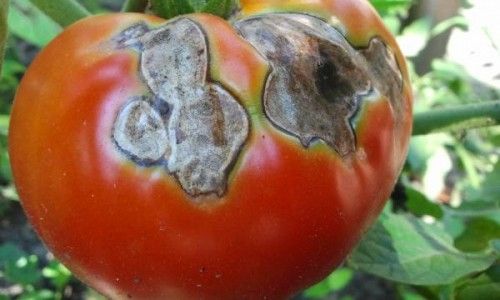
Therefore, taking for the cultivation of such a delicate culture, you need to fully possess information on the procedure for the care, various intricacies and tricks, helping to collect a more generous harvest. The greenhouse will help in this process with its properties, its use will facilitate your labor duties.


